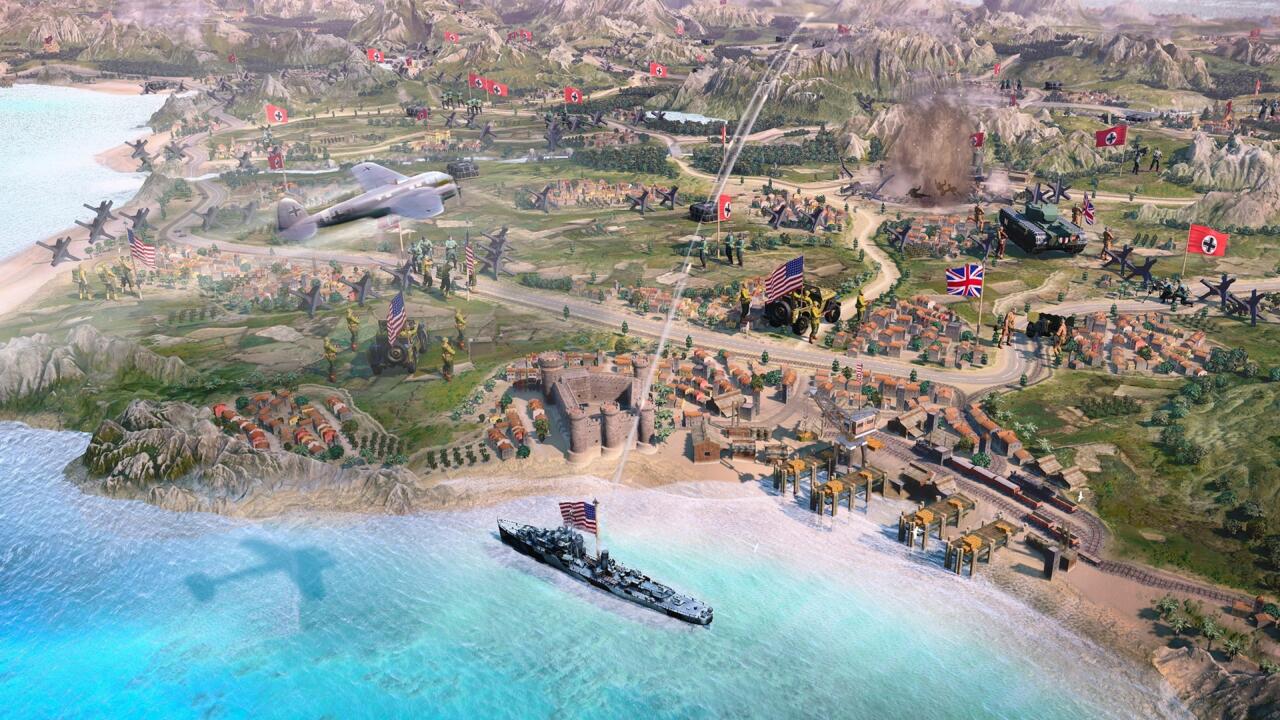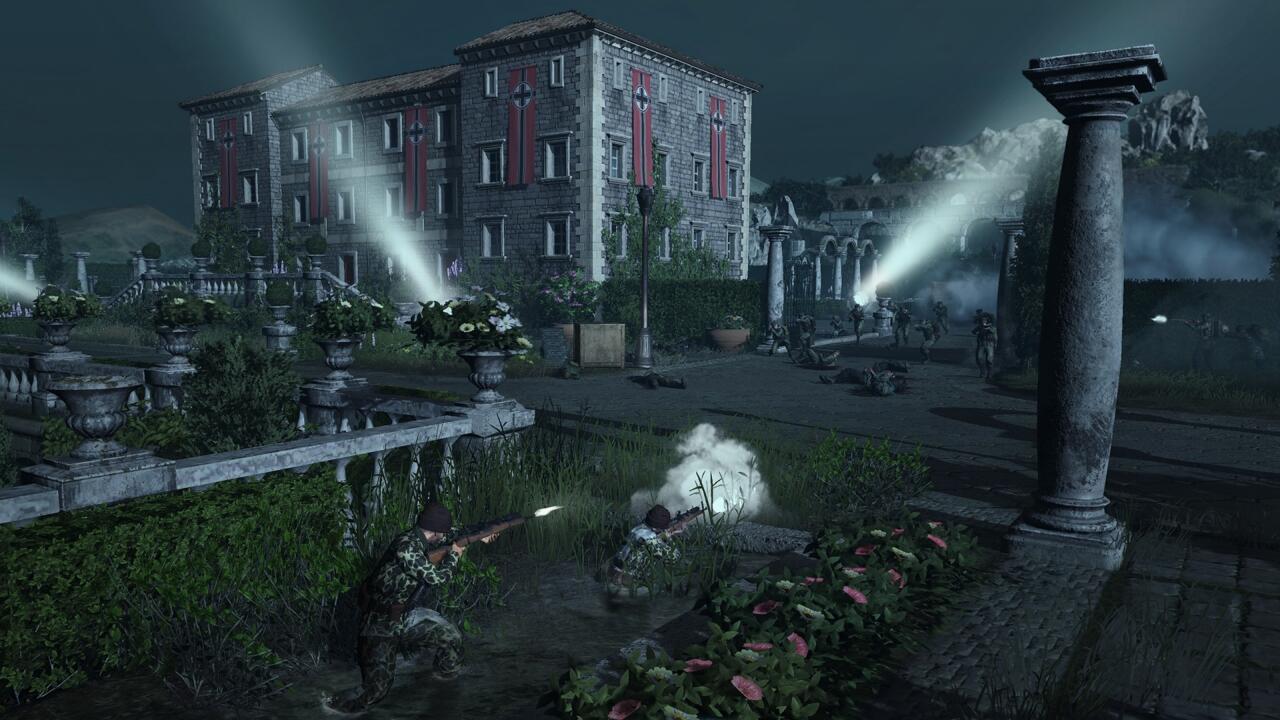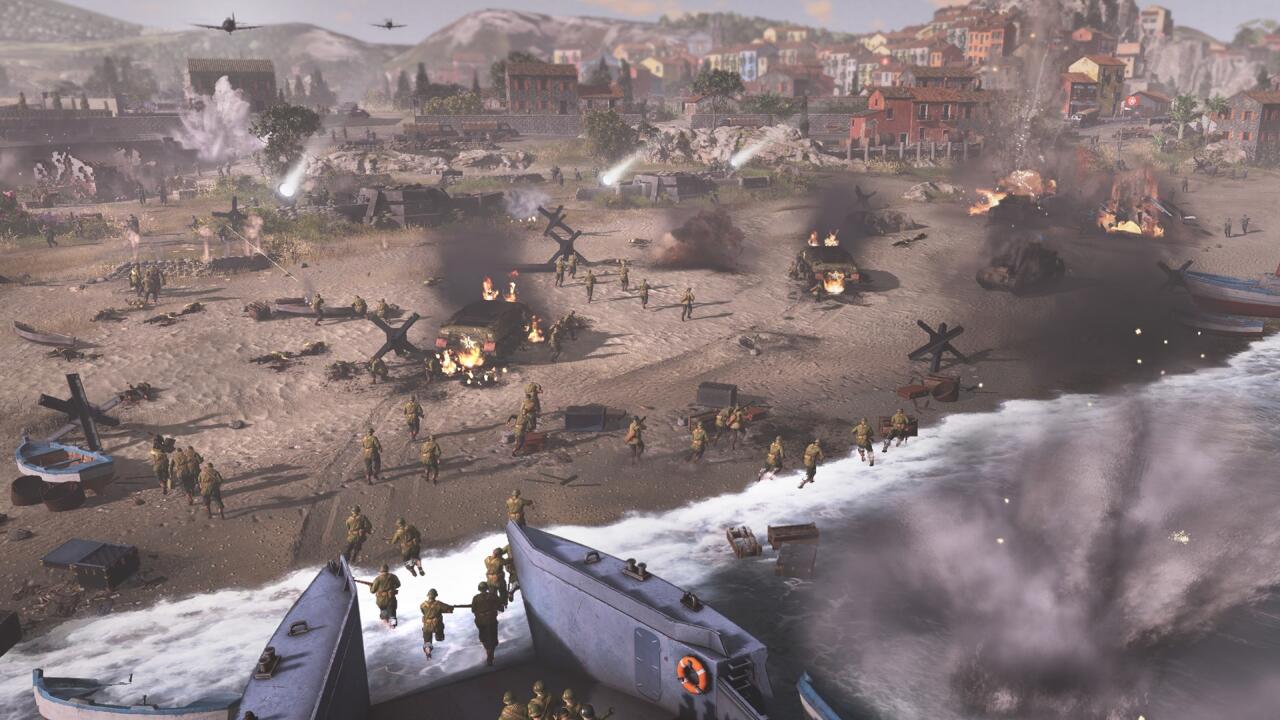A lot of the gameplay in Company of Heroes 3 is what you'd expect. It's the return of Relic Entertainment's brand of World War II real-time strategy, requiring tight command of squads and vehicles that's more about directing your soldiers to cover and executing flanking maneuvers than fast movement, tons of units, and lots of mouse clicks. What's striking about the next entry in Relic's long-running strategy series is that it's basically two games in one, with a whole additional turn-based strategy game on top of the RTS. That new second half works to give you more control over the flow of the war effort--and lets you essentially create a single-player campaign of your own.
We recently spent around four hours playing an early preview build of Company of Heroes 3 on PC, which gave a look at how Relic's return to World War II will function. It contains a lot of alterations that give you greater command of the battlefield, both squad-by-squad and on a much larger scale. The changes make Company of Heroes 3's single-player mode feel pretty enormous, while giving you a huge amount of control over how your campaign plays out.
CoH 3 puts you in control of the Allied campaign in the Mediterranean, a portion of the war Relic says has been neglected in media over the years, and which contains a lot of lesser-known but no-less-heroic stories. Our play session had us pushing up from the coastal city of Naples in an attempt to capture the mountain cathedral stronghold of Montecassino. That campaign through coastal towns was handled on the Dynamic Campaign Map, which is reminiscent of what you might see in big turn-based titles like the Civilization series. It shows towns, roads, and your military forces almost like pieces on a game board, giving you a broad-strokes idea of how the war is playing out and operating as each side takes turns moving forces and attacking different locations.
The campaign map gives you options for how to direct the war effort according to your strategy. As you capture towns, you increase the resources at your disposal and the territory you control. Those resources can be spent on deploying different kinds of military units: Companies are your main forces and can be moved around the battlefield to engage other forces and come in varieties such as special forces groups, tank squads, and paratroopers. Detachments are smaller units such as .40-caliber machine gun squads or medic groups, and can support your companies with their specializations, like healing them or providing artillery support.
The turn-based map gives you a top-level view of everything going on in the war, allowing you to create supply lines for your troops and disrupt them for your enemy, capture airfields to bomb enemy positions, and make plans for how you want to take on tougher foes or assault important locations. You can use bombers and detachments to soften up an enemy company, for instance, and then move your own ground forces in to engage them once their power has been reduced.
Combat between smaller units happens on the campaign map, and you can even destroy groups of soldiers with smart plays in the turn-based game. But for bigger, more important, or more nuanced engagements, you're pulled into more intimate RTS missions. These battles happen when you attack specific towns, take on side objectives, and hit important moments in the campaign, but there are also smaller "skirmish" RTS missions created any time one of your companies meets with an enemy one. It's in these RTS missions where you'll see more of Company of Heroes' classic gameplay.

This is also where a lot of the dynamism of the turn-based game starts to have serious effects on your RTS battles; you can choose when, where, and how to fight the enemy, and while you might hit certain chokepoint missions in the campaign like big historical battles, you're not necessarily required to fight every engagement that really happened. And your choices are reflected back in the choices of the enemy--allow a company to retreat after kicking their garrison out of an airfield, for example, and you'll be giving them time to heal up and gain experience to become a more formidable foe later on. How you choose to fight through the Mediterranean determines what battles you'll face and what story you'll ultimately tell.
"The distance between landing on a beach and reaching the mission objective is a heck of a lot of distance in terms of the kinds of challenges that commanders had, the kinds of things they needed to be concerned with," lead campaign designer Andrew Denault explained in an interview with GameSpot. "And so for us, it was how can we get that, in terms of gameplay, in front of the player in an interesting way, to generate some fantastic connective tissue between missions that focuses on the players manipulation of their companies? Am I in supply? Is my company in good health? Et cetera, et cetera."
"We wanted to widen the gameplay angle for the player, rather than seeing the gameplay experience as a linear number of missions with interesting cinematics and then pulse-pounding RTS and great action and all the cinema that the player's accustomed to," he said. "We wanted to expand on that and allow the player to fill in the blanks with regards to some of the narrative."
The story of your campaign through the Mediterranean is also determined by how you approach different objectives and what you value in your campaign. As you play, you'll be contacted by three different sub-commanders who serve as advisers, each with a different general agenda. They provide you with their own ideas and battle plans as the campaign progresses, while also bringing your attention to side missions that they think are important. The American general on your team might try to send you to take out a high-level German officer, while the OSS operative wants you to help Italian Partisans resisting German occupation on the ground.

You won't have the time or resources to take on all their missions, and often each one's view of the best option to meet an objective is at odds with the others--so who you listen to and what you choose to do will shape how your campaign plays out. That's controlled by a system Denault called the Event Director, which pays attention to your behavior and actions, logs whose advice you listen to, and makes tweaks to the campaign as it's playing out.
So you'll have big RTS missions like Montecassino, which is a major point in the story, but it'll be informed by smaller missions you play along the way to do things like build a Partisan information network or capture a nearby airfield. Then, as you approach Montecassino, you're given options based on what you've done. Should you bomb the position to weaken the enemy forces there? Should you fly recon to see what you're up against, but risk a plane? Should you send in Partisans to learn about the situation, and the possibility of civilians in the area? What you do determines how the battle plays out and can influence what information you have so you can make better battlefield decisions.
"The Event Director will generate events that [the sub-commanders] will attach to and say, 'Hey, that's important to me. You should totally do that. You should focus on shoring up your supply lines here. You should really capture another seaport on the east coast. These partisans are in trouble. You should be focusing on supporting the partisans and the resistance effort,'" Denault said. "And so the storytelling, of course, is going to be a huge component of our missions, but a lot of the story is going to be living in the map. We've used this terminology in studio of a living world, and the concept that the player can be moving from mission space to mission space, triggering not only the more dynamic skirmish missions that don't have as much story encapsulated in them. But we're still leading up to these moments on the campaign map with these events, constantly giving the player an idea of what's going on in the world, that the conflict wasn't really just about these epic battles, that there were smaller stories to be told. And so I think it's really us focusing on building up this connective tissue between the missions."
As Denault mentioned, the journey from the beach to the objective was a long one in our preview. Fighting through occupied territory on the campaign map can be a long, arduous process, with a lot that can go wrong. Take the most obvious path toward an enemy position and you might hit landmines used to block off a road, or wander right past a hidden machine gun nest that rips into your company before you can get clear. Those strategic missteps have consequences, too--when you inevitably join an RTS mission with a damaged company, you might find your soldiers with lower health, or your squads spawn with fewer soldiers than when you're at full strength.

Fans of the Company of Heroes franchise will immediately recognize many of the elements of CoH 3's RTS gameplay, though; while there are a lot of big changes to how the campaign flows to make it more dynamic, those changes are always leading to the tough infantry and vehicle battles the franchise is known for. CoH 3's RTS gameplay draws a lot from the first Company of Heroes, with base-building and resource management requirements on most maps. You'll want to take territory to increase your resources, so you can create more units of various types. The longer your squads stay on the battlefield, the more experienced and stronger they become. Taking cover, flanking, and using abilities and different types of units to destroy cover or level buildings is also essential for victory, and Relic has amped up the amount of destruction you can wreak on its maps. You can also use a new tactical breach-and-clear ability to send your squads in to clear out enemies garrisoned in structures to take away defensive advantages.
Even the skirmish RTS missions we played were pretty tough, punishing you for sending squads out into the open and forcing you to find creative ways to deal with enemy vehicles or entrenched forces. Adapting to changing battlefield conditions is part of the feel from past Company of Heroes games, but in CoH 3, Relic has worked to make the game a little more approachable even if you're not a seasoned vet. Apart from the dynamic campaign map, the most obvious new change is the Tactical Pause feature, which allows you to stop the action at any time in an RTS mission. With the game paused, you can catch your breath and assess the situation, and even take a minute to queue up actions for your squads to move them around the battlefield and send them to key positions.
You don't have to use the new pause feature, but it does give you opportunities in RTS missions to avert disaster--and it allows you to be a little smarter in your strategies. So much of Company of Heroes 3 is about outthinking and out-positioning the enemy, so the pause feature often gives you a chance to look around big mission maps and move your squads to smarter places to fight. Things can change quickly, so you still have to be on your toes, but the tactical pause gives you the opportunity to handle the battle more intelligently, especially on big maps with multiple objectives. Of course, though, there's no tactical pause in multiplayer, so don't expect to force other players to freeze while you figure out how to counter their Panzers.
Even over just a few hours, though, Company of Heroes 3 felt remarkably large, expansive, and adaptive. Relic says it's designing the game with its focus on providing tools for CoH 3's sandbox, which means that there are a lot more moving parts in the game at any given time, and that battles will feel different from one another because of all the elements that could potentially be in play. From what we've seen, CoH 3 captures the intensity that has made the Company of Heroes franchise popular among RTS fans, while adding a lot of new ideas that provide plenty of different, additional strategy gameplay to the mix. This feels like an enormous, dynamic strategy title, and it'll be interesting to see just how the Mediterranean campaign plays out when we're given full control over the war effort.
Look for Company of Heroes 3 on PC sometime in 2022.




